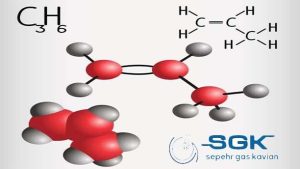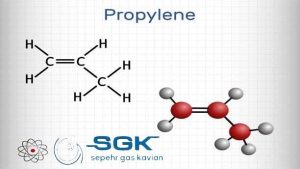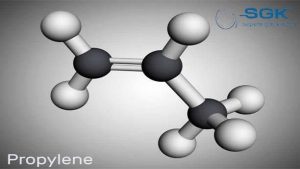Propylene gas
Propylene gas C3H6 is a chemical formula that refers to the propylene molecule. In this formula, C means Carbon and H means Hydrogen. This gas is a colorless, mild-smelling, light hydrocarbon that is compressible as a gas under standard conditions.
Sepher gas kavian company is active in the field of producing and importing propylene gases for various industries, high quality laboratory equipment and gas mixtures (calibration gases) and all equipment related to various industries.
The volume of cylinders and capsules available for charging propylene gas is: 5 liter cylinder, 10 liter cylinder, 50 liter cylinder, DIN1 or BS4 cylinders.
Imported propylene gas is available in grade 9/99.
99.9 grade propylene gas is available in 0.75 kg in 5 liter cylinder, 1.5 kg in 10 liter cylinder and 17-20 kg in 50 liter cylinder in carbon steel cylinders.

Resources
C3H6 is supplied from different sources. In the following, I will review some of the main sources of this gas supply:
- Crude oil: Propylene is naturally present in crude oil. During the distillation process of crude oil in refineries, this gas is separated and produced as a side process.
- Natural gas: This gas is naturally present in some sources of natural gas. In the natural gas extraction process, after separating other gases, this gas is separated in liquid form.
- Refineries: In refineries, this gas is produced as a process product. These refineries can use crude oil, natural gas and other raw materials to produce propylene.
- Chemical industries: Some chemical industries directly produce propylene. These companies can use crude oil, natural gas and other chemical sources to produce this gas industrially.
- Exchange and international trade: This gas is also provided through exchange and international trade. Companies can buy from global markets and import C3H6 into their country.
Technical specification
| chemical formula | C3H6 |
| Molecular Weight | 42.08 g/mol |
| Color | Colorless |
| Odor | Mild smell |
| Boiling point | About -47 degrees Celsius |
| Density | About 0.84 grams per cubic centimeter |
| Flammability | It is normally flammable in the presence of air and has a flammable concentration range from about 2.3% to 11.4% by volume. |
| chemical properties | Hydrocarbon is unsaturated and can participate in various chemical reactions. |

Application
- Plastic production: This gas is used as a raw material in the plastic production industry. Most of the plastics that owe their raw material to this gas are known as propylene. This gas is used in the production of car parts, household appliances, packaging, cosmetics and other industries.
- Dormitory Industry: Propylene is used in the production of carpets, machine carpets and covering materials in the dormitory industry. This use is due to the mechanical properties, heat resistance and color acceptability of this gas.
- Automotive industry: C3H6 is used in the production of car parts such as windows, ventilation systems, car interior parts and radiator beams. This use is due to the mechanical properties, impact resistance and light weight of this gas.
- Piping and pipe making industry: C3H6 is used as a corrosion and chemical resistant material in piping and pipe making industries. The pipes of this gas are used as gas, water, sewage and chemical industry lines.
- Paint and resin industries: This gas is used in the production of paints, resins, lubricants and lubricants.
- Electronic industry: propylene is used in the production of electronic products such as bottles and protective covers.

Danger
C3H6 gas, like many other chemicals, poses risks to humans and the environment if not used properly.
- Fire and explosion: This gas is a flammable substance and in case of flammable condensation, contact with burns, strong heat sources, as well as contact with open air will cause a strong explosive reaction. This issue can lead to fire and explosion incidents.
- Invasion of the respiratory system: Breathing propylene gas in large amounts can be aggressive on the respiratory system and cause complications such as shortness of breath, inflammation of the lungs, and damage to the mucous membrane.
- Invasion to eyes and skin: direct contact of this gas with eyes and skin can cause irritation and aggression and cause side effects such as inflammation, itching, redness and burning.
- Environmental effects: The release of C3H6 as an impurity in the environment can lead to air, water and soil pollution. These effects can negatively affect the life of animals, plants and ecosystems.
- Hazards from Improper Use: Improper use of this gas, such as improper storage, use in unqualified safety environments, and failure to follow safety instructions, can create additional hazards and cause accidents and serious injuries.





